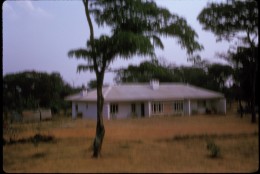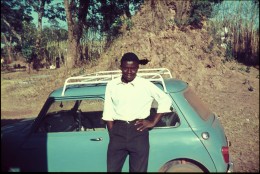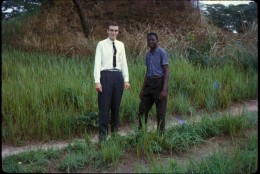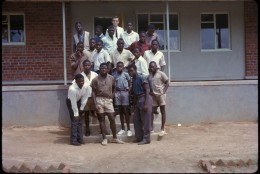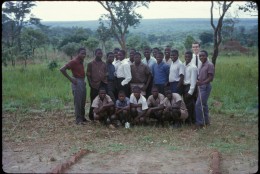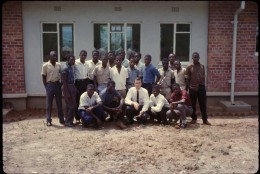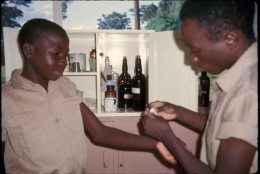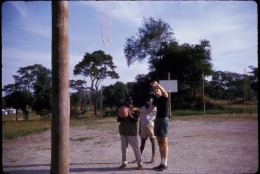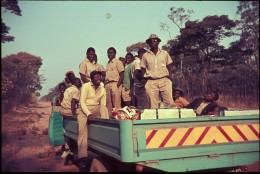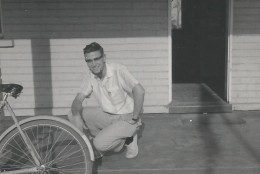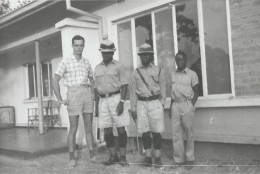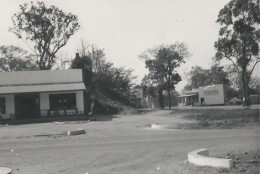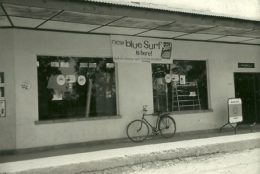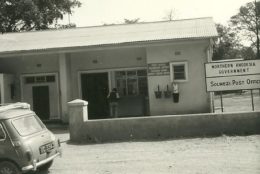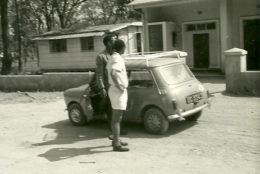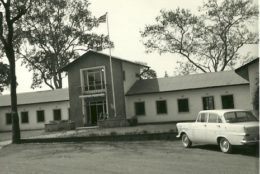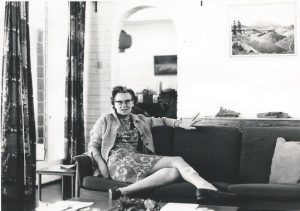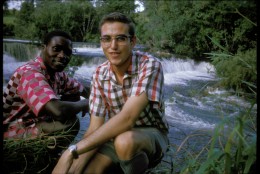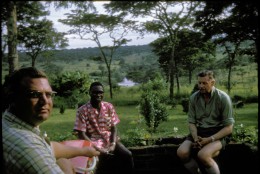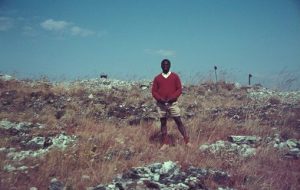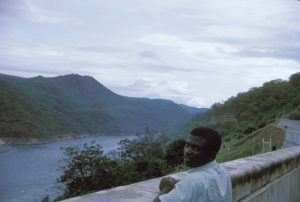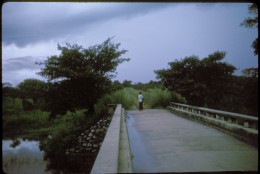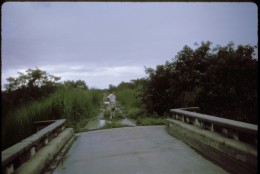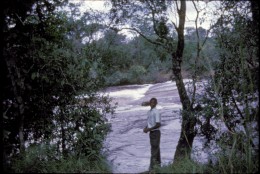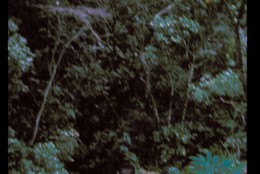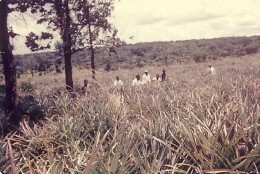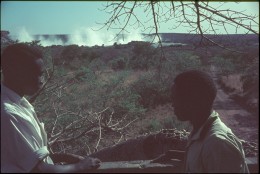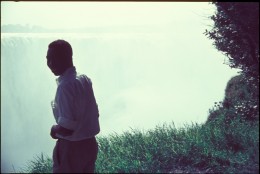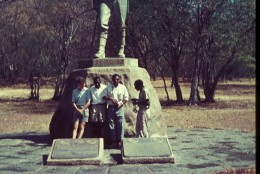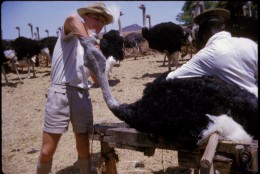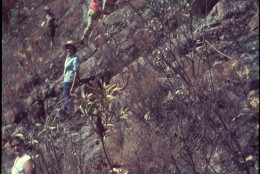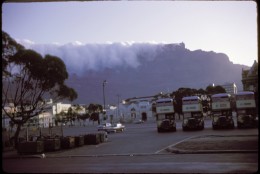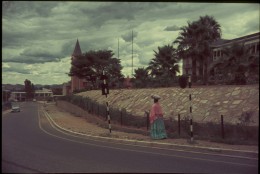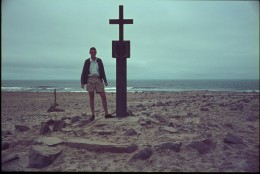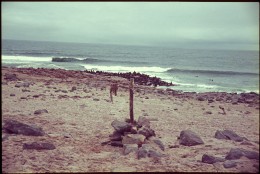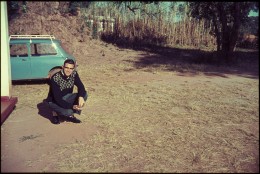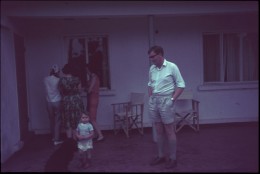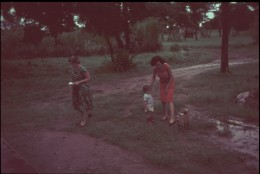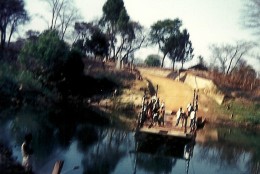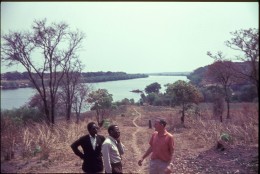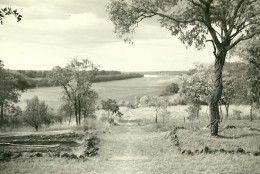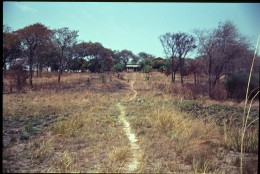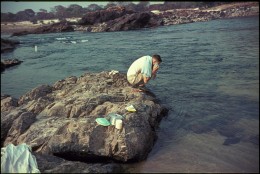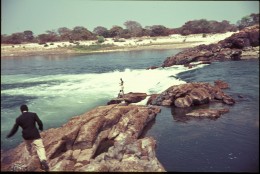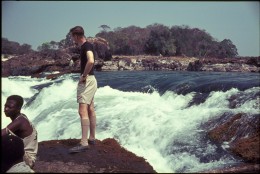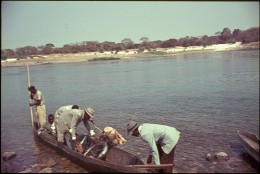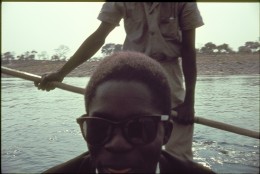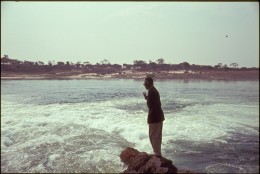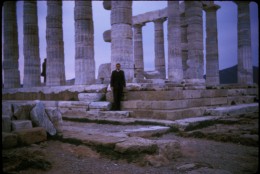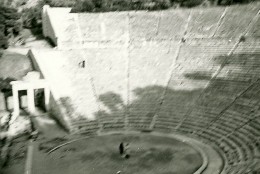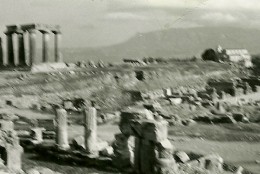Solwezi Secondary School: 1963-65 — A new life in Zambia begins
2018: a special note about pictures and pdf text on this page:
- New changes. Some years ago, I started this basic website with some of the pictures that still appear on this webpage. Later I learned how to enhance these pictures when someone clicked on them. Only recently, however, have I made substantial revisions, by incorporating vignettes from letters to my family in Ohio that add specific details and dates when events happened. (These materials are pull down pdfs enhanced by Lightbox.) They are meant for you if you or someone in your family attended Solwezi (SSS) in this period or if you have an historical interest in Solwezi in this time period.
- Nisbet Photographs. In late 2015 and early 2016, I added many photographs taken by Alex Nisbet, not only for Solwezi but also for his earlier life when he was at Chitokoloki. To see these Nisbet Photographs,click on the following direct link: Nisbet Photos.
August 1963: arrival in the NWP
While I had taught in a multi-ethnic school in the city of Cleveland, I was certainly not wise to the wider world. While time in London helped me understand the wider English-speaking world, this was not adequate to prepare for living in what was still Northern Rhodesia. Immediately after arrival in Ndola, a cosmopolitan center of Zambia’s copper mining region (simply called the Copperbelt), I was quickly hustled off 200 kilometers west to Solwezi, the eastern-most corner, and capital, of the NWP. Below are pictures of my home and neighbours (all fellow teachers at SSS) also an extract from my letters about this arrival >: Solwezi Arrival 1963
- House at SSS: lived on left side (1965) & right side (1966-67)
- House at SSS: w/my car & John/Gwen Parry’s (right)
- Joseph (my housekeeper) in front of my Morris Mini
New School Term at Solwezi Secondary School (SSS) for boys
The school’s new term had started just before I arrived. I plunged in immediately with a very full teaching schedule. My learning curve as a teacher was enormous as they desperately needed me to tackle subjects that I had never taught before. I taught several Form I English classes (junior high school) as well as a Form IV History class (like 11th grade to Americans). All students had been highly selected to get into secondary school and spoke and wrote far better English, a second language for most, than I was used to when teaching in Cleveland. Many had a British accent and certainly spelled as the British would.
Besides teaching, I was asked to supervise Chuma House. This was one of six dormitories for this boys’ school. In addition, I was also placed in charge of both the school’s very small medical dispensary and its library.
Chuma House Dormitory
- Watson Kaira & David Wilkin
- Chuma House 1
- Chuma House 2
- Chuma House 3
- Chuma House 4
Solwezi’s Library, Clinic, Basketball, Travel, and Bob Hammond
- Library: Boaz Chilila and Willie Sweta
- Clinic: _____ and Willie Sweta
- SSS’s Basketball Court: we were later “massacred” by Chingola SS
- SSS’s “School bus” to Chingola and remoter parts of the NWP
- Outside our library or clinic
- Preparing for a school play about colonial police
Wider Challenges
The mid-1963, local geographical, social, political environments also presented me with many new challenges, both easy and quite difficult. For example, having spent long periods on my grandparents farms in Ohio, I easily related to the rural life of the NWP. Having also been raised in a very conservative Christian community, I could also immediately relate to the conservative Christian environment that pervaded the government school. In contrast, I was immediately deeply troubled by British Colonial society in the waning days of Northern Rhodesia. New Zambian officials were being hastily trained for government positions and society was also being transformed, but often more slowly. The Anglican church (only English-speaking church) was open for all and Solwezi’s private social club had just invited its first Zambians to enter as the color bar started fading. Still race mattered in a multiple ways, some very subtle and some still quite obvious.
Solwezi Town
The main town was about 3 km. (1 1/2 miles) away making for a long walk, even with short-cut paths through the woods, or a short drive. Three fairly large stores had basic (but expensive) supplies and were branches of their larger Copperbelt stores. See pictures below of the town centre and these stores.
Solwezi Town Centre: Main street, stores, P.O. and Provincial Boma
- Solwezi’s unpaved main street 1964
- Two of Solwezi’s biggest stores
- Store on main street close-up
- Solwezi’s main PO
- Main PO with Mini and two teachers (Ike Toka in front)
- Main provincial boma building
Roads and cars
No paved roads in the NWP. Throughout this period, from not only 1963-68, but also 1970-79, there was not a single paved road in the NWP. The nearest paved road was reached just outside Chingola in the Copperbelt, about 160 km. to the east.
Morris Mini (picture above). Despite no paved roads, I somewhat foolishly purchased a small Morris Mini. On Solwezi’s roads it was marginally useful and much less so in the rest of this vast province stretching westward almost 600 km. Although not a mechanic, I nonetheless, relentlessly traveled throughout the NWP until the end of 1964 when I moved to Zambezi. A guardian angel seemingly watched over me and I never had a serious accident nor was I forced to sleep along the road for even a full night. As transport was so desperately needed, I almost never traveled alone, but had more than one passenger as well as supplies.
Racism confronted
In Ohio in the early 1960s, I had worked against racism in all its forms, but here I confronted a different version that took me off guard. I immediately learned that Americans (of all races) were regarded as “European.” Individuals of both races were very polite and cordial. The British simply endured my view of society while Africans regarded me as a kindly white guy who differed somewhat from British officials.
Mindolo, Mutanda and new friends
Shortly after settling into Zambian life, I accidentally visited the Mindolo Ecumenical Centre in Kitwe and thereafter visited it regularly whenever I went to get supplies on the Copperbelt. It was devoted to religious and racial healing as Northern Rhodesia transitioned into Zambia — from colonial colony to an independent nation. Here, I immediately found new friends, first Jeff Iredale and Jones Banda, whose photos appear below and later Muriel Williams (later Sanderson). The photos of Jeff and Jones were taken when they later visited Solwezi and Mutanda. Read the vignette (a PDF file) about my first impressions of Mindolo: Mindolo 1963. You might also like to check the whole webpage on Muriel: Muriel in Botswana
- Muriel Williams Sanderson receiving award from Pres. Kenneth Kaunda
- Muriel Williams Sanderson relaxing at Mindolo
Mutanda Mission (30 km. to the west of Solwezi) was quite different from Mindolo. It was part of the South African General Mission (SAGM), an international conservative evangelical group. SAGM later became part of the Africa Evangelical Fellowship (AEF) in Zambia and SIM internationally. (AEF still receives some international funding and help from SIM.) In 1963, Mike Warburton (from America) was a senior leader. He and his wife’s hospitality were always appreciated and also he helped church services at the secondary school.
- Jones Banda and David at Mutanda River and Mission
- Teachers & school boys at Mutanda River & Mission
- Mike Warburton, Jones Banda & Jeff Iredale
Extensive travels in 1963-4 with Philip Muke and others
The “wide-open” spaces of the enormous NWP, the rest of Northern Rhodesia, Southern Rhodesia, South Africa and S.W. Africa (later Namibia) all beckoned me. In the space of about 18 months after I arrived in Solwezi in August 1963, I traveled southern Africa quite extensively before I moved to Balovale (Zambezi) in January 1964.
In six letters to my family in late 1963, I described the school and also my first travels to points south in Northern Rhodesia and Southern Rhodesia, especially Livingstone (Victoria Falls), Bulawayo, Harare (then Salisbury). These travels took place whenever school duties permitted me to leave Solwezi. I mention for the first time Dr. Brown (first name I have forgotten) at the United States Information Services (U.S.I.S.) in Salisbury. He was one of the most amazing men I have ever met in my life; an African-American probably appointed in the Kennedy period. In the last section of this correspondence is a letter to J.O.A. Herrington in London (12th Dec.) asking him to pass on my application for a second year as Fulbright teacher. (These letters are dated 30th Sept., 11th Oct., 21st Oct., 3rd Nov., 11th Nov. and 8th Dec.) Beginning Travels: Late Sept. to 15 Dec. 1963
Note: When I drafted this Solwezi page for the website four years ago, I wrote from memory and had not yet reread these old letters. Thus, I had forgot how extensive these travels had been! Now, as I continue to reread and edit these old vignettes from my letters, this part of the Solwezi page will be slowly expanded in the latter part of 2018. While I will not describe all these travels in a strict chronological order, I will be careful to note exact dates. Also, some of the pdf files will include my main experiences in almost tiresome detail for anyone interested in my basic stories of Solwezi in 1963-1964!
Kansanshi Mine in 1963-64 and Kariba Dam with Philip Muke. At this time, Kansanshi Mine was still a large hill — just behind us. It is now a very large open-pit, one of Zambia’s largest and most profitable. Kariba Dam, which we generally saw when when visiting Livingstone or on our way to Salisbury (now Harare) in on the right.
- Muke standing on Kansanshi Mine Hill — now a deep open mile pit
- Muke (and Samson) at edge of Kansanshi Mine Hill– now a deep open mile pit
- Muke at Kariba Dam
Mwinilunga with Philip Muke. On the 1964 long Easter weekend holiday, I set out with Philip, a senior student as my guide, to visit Kalene in the northern corner of Mwinilunga District. Kalene was Philip’s birthplace and he was eager to show me his home district. (Like many other school “boys,” Philip was as old as I was.) As noted in the pictures below, we went to the source of the Zambezi, the Zambezi rapids, the bridge leading across the border to Angola, large pineapple fields, and some CMML missions stations of historical note. These places are described elsewhere on this website. Click the following for words from my letters: To Mwinilunga: Easter Weekend 1964
As I continue updating this Solwezi page, I will note other places where Philip and I traveled. These included Kansanshi copper mine (see two pictures above), which was just 12 km from the school. Also Kariba Dam (above) and later on Livingstone and Salisbury (now Harare).
- David at the Zambezi Rapids
- Zambezi/Angola border north of Kalene
- Muke at the Zambezi Rapids
- Muke walking down to the source of the mighty Zambezi River
- Pineapple fields near Muke’s home
Livingstone and the Victoria Falls. In late September 1963, I make my first visit to the Falls, about 20 km from Livingstone. I would visit this city and the Falls nearby very often. Later in 2018, I will quote vignettes from my letters to my parents with my initial observations as I update this page.
The pictures below illustrate one trip with several students and a teacher. I took the students as a reward for good writing.
- Boaz Chilila & Willie Sweta
- Boaz Chilila facing the mist of Victoria Falls
- David Livingstone Statue
Salisbury (now Harare). After my very first visit to the Falls, I drove south into Southern Rhodesia via the Wankie (now Hwange) Game Park and Bulawayo to Salisbury. [I will add many vignettes later.] At that time, at least for me, Salisbury was almost an awesome place, a “real” city like what I was used to in America; not the mining towns, or a “cow” town, or “whatever” Lusaka was!
December 1963-January 1964: Zimbabwe, South Africa and Namibia
On the long six week school holiday In Dec. 1963 and Jan. 1964, I took off for Cape Town with Clive Inman, a student teacher from the UK. We traveled though the Zimbabwe ruins, then Johannesburg (and Soweto), and along the Garden Route, to Cape Town (CT). Before reaching CT, we stopped for a long weekend at Genadendal, where we joined an ecumenical multi-racial youth gathering. It is quite memorable to me, not only for the delightful religious camaraderie and an extraordinary climb into the nearby hills, but also because such interracial gatherings were still only semi-legal in apartheid South Africa.
Namibia. From CT, I flew to Windhoek, capital of Namibia (then South West Africa). From Windhoek, I took a train west to the Atlantic coast and saw the amazing desert cities of Swakomund and Walvis Bay. Then I went by tourist land rover northwards to see the seal rookery at Cape Horn. To read about these journeys, open this pdf file. It is a composite of 13 pages of material from several letters: South African travel: Dec. 1963 to Jan. 1964.
Assorted Pictures of my trip to Cape Town and Namibia: Ostriches at Oudtshoorn, Genadendal (Western Cape), Cape Town, Windhoek and Cape Cross’s seal rookery.
- An ostrich: like sitting on a horse w/feathers
- An ostrich demonstration: no teeth!
- Ringing the bell at the old Moravian Church
- Climbing the hill behind Genadendal
- Cape Town w/its tablecloth on
- Herero woman in central Windhoek
- Cape Cross monument
- Seal rookery at Cape Cross
I had a safe journey back to Zambia, and continued my teaching at Solwezi.
A sad tragedy: May 1963
Several months after my return from my big trip to South Africa (next major school holiday), I set out again for South Africa. Unlike my prior journey, this trip did not end well. Driving in a separate car, I accompanied three fellow teachers from Solwezi to Livingstone before driving on to South Africa. Several weeks later, when I reached Port Elizabeth, I learned of their tragic deaths. They had a terrible head-on car crash in the Southern Province of Zambia, as they were returning to Solwezi. All adults were instantly killed; only John and Angela Nash’s baby survived — unharmed. The third adult who died was Abe Hassan, a new teacher from Cape Town. On the right below, see two pictures of Gwen (orange dress) and the daughter. When I heard of their deaths, I determinedly drove over 1400 km. non-stop back to Zambia; longest non-stop drive in my whole life.
- End of dry season, 1963: Paul David Wilkin w/first Morris Min (front of his first home)
- John and Angela Nash (later killed in car crash) with their daughter, with Gwen Parry and Marjorie Nisbet facing away
- Angela Nash (w/daughter) and Marjorie Nisbet
Effects of the tragedy. Solwezi Secondary School was devastated, and not only psychologically. Losing three teachers out of a teaching staff of about 14 was difficult as the new school term was ready to start. It would take the Ministry of Education in Lusaka six months to fill the vacancies. Everyone filled in as much as possible to keep the school from shutting down.The following pdf file, with my correspondence from 18th February through 6th July 1963, contains the details of this sad tragedy as well as events before and after: Solwezi Disaster: May 1964
Mid-1964, Independence fever and new travel plans. Independence fever was hitting Zambia, including the NWP and Solwezi Secondary School. Zambians were ecstatic to soon be free of British rule. Conversely, whites were very nervous as they tended to focus on the Congo’s chaotic independence. (The Congo was, and still is, the northern border of both the NWP and the Copperbelt Provinces.) Prices of expensive goods dropped drastically and I got some of the greatest retail bargains in my life during this tense period! Fortunately, the optimists, myself included, proved correct. As the celebrations approached, I decided this would be a good time to see the far western regions of the NWP and also decide if I wanted to be adventurous and apply to move to a new school that would open in Balovale (later Zambezi).
Two drives west to Balovale (Zambezi): August 1964 and then for Independence celebrations in October
In August 1964, Thomas Samungole, a senior student my age and still a very dear friend today, escorted me to see Zambezi District. (At that time the district straddled the mighty Zambezi River.) This was his home region. The distance from Solwezi was approximately 350 miles (550 km). The road was all gravel and dirt with deep sand in a few places, especially between Kabompo and Zambezi towns. Somehow we made it through and back to Solwezi in my tiny Morris Mini. After we returned to Solwezi, I purchased a black Volvo — better for the NWP’s dirt roads — before we set out for the Independence celebrations on 24th October.
At that time the fast flowing Kabompo River could still only be crossed by a pontoon. (A much-needed bridge was only built in the 1970s.) Lying far from any town and with no place to stay (especially when heading west), you had to plan your trip to get across before the pontoon closed just after sunset. If one did not get across in time, you had to sleep in your car and face hordes of mosquitoes! Many an accident occurred as people rushed at high speeds on the bad dirt roads to get across before dark.
Kabompo Pontoon and unpaved roads in the NWP: 1960s / 1970s
- Kabompo pontoon — looking one direction
- Kabompo pontoon — looking another direction
- Main NWP dirt road
On the August trip, we stopped at the Trades School just outside Balovale town. We would again visit the school in October as it was to be replaced in January 1965 by a new secondary school where we would teach.
- Samungole, Banda and Furth
- Looking at a northern bend of the river
- Looking up from the river to the H/M’s house
On the first trip, after reaching Balovale town, we turned north and drove along the east bank of the Zambezi River for 80 km. to Chavuma. (Chavuma is now a separate district.) Leaving the Morris Mini on the east bank, we crossed the river by pontoon and dugout canoe so that Thomas Samungole could briefly visit his family on the west bank.
Chavuma and Chavuma Falls and crossing to the West Bank
- Bathing before crossing
- Chavuma Falls looking west
- Close-up of Falls
- Dugout canoe and passengers
- The crossing
- Thomas pointing east
- Thomas Samungole greeting relatives
Independence celebrations in Balovale (now Zambezi): 24 October 1964. On our second trip in October, we spent our time in Balovale town for the big celebrations. As elsewhere in Zambia, the celebrations were the biggest events of the year. On both trips, we stayed in the small government rest house. The small private club (formerly whites only, but by independence more black than white) was the focus of many celebrations. Both Thomas and I had a wonderful time. At the club, I met a South African nurse, Miriam Zindi Nondomiso Gqomo, who within six months become Mrs. Wilkin. She had been in Zambezi less than a year as a refugee from South Africa’s apartheid.The following pdf file, contains my correspondence from 26th July through 15th November 1963. Both trips are described as well as my final days of teaching in Solwezi: Balovale: August-October 1964
Short visit to Ohio at the end of 1964
Just before I moved to Zambezi (then Balovale) in January, I made a short visit home to the USA. I surprised my parents, which were then both living, by walking in the house unannounced. This was to be the last time I would see my mother before she died in 1967. I have no remaining pictures of this visit, but below are pictures of Greece on a stop-over on my way to America.
Greece: Dec. 1964
To continue the narrative of my life in the NWP, that now continues with Zambezi (Balovale) Secondary School
1965-1967, click on the following link: Zambezi (Balovale)


